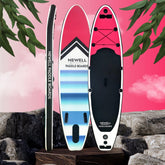What is a Paddleboard Safety Leash and How to Attach It
What is a Paddleboard Safety Leash and How to Attach It
What is a SUP Safety Leash?
A SUP (Stand-Up Paddleboard) safety leash is a vital accessory designed to keep you connected to your paddleboard while you're on the water. This leash is typically made of a durable, elastic cord that attaches to both your board and your ankle or calf.
The main purpose of the SUP safety leash is to prevent your board from drifting away if you fall off, ensuring that it stays within reach and reducing the risk of losing it or encountering dangerous situations. By maintaining a secure connection, the leash enhances your safety and allows for a more enjoyable paddling experience.

Types of Paddleboard Leashes
Choosing the right leash is crucial for safety and performance while paddleboarding. Here’s a guide to the three primary types of paddleboard leashes—waist attachment, calf attachment, and ankle attachment—each designed for specific needs and conditions.
Waist Attachment Leash
A waist attachment leash offers quick access to the release mechanism, which is essential in emergencies. This type is especially popular in Whitewater River SUP (Stand-Up Paddleboarding), where paddlers may encounter hazards such as strainers, rocks, or fallen trees. The leash attaches to your Personal Floatation Device (PFD), making it easier to disengage quickly if you get caught.
In SUP racing, particularly in the Technical Beach Racing format, a waist attachment leash provides a strategic advantage. It allows racers to release the leash easily during the final sprint to the finish line, ensuring that the leash doesn’t interfere with their performance. For optimal use, mount the leash securely to your PFD to keep it accessible yet unobtrusive.

Calf Attachment Leash
The calf attachment leash is the preferred choice for Stand-Up Paddleboard racing. By connecting the leash to your calf, it remains elevated out of the water and reduces the risk of tangling around your ankle.
This setup is particularly advantageous during buoy turns, where quick and agile movements are crucial. Typically, this leash is designed as a coil, which helps to keep it streamlined and avoids drag, ensuring it stays out of your way while racing.

Ankle Attachment Leash
The ankle attachment leash is the most common type among paddleboarders and is essential for maintaining connection with your board. This leash ensures you stay tethered to your board, which is vital for safety and convenience. It’s included as a standard accessory with most inflatable paddleboards.
For general all-around paddling on flat water—whether cruising or touring—a straight ankle cuff leash is ideal. It’s particularly suited for beginners due to its simplicity and effectiveness.
In SUP surfing, the ankle attachment leash also plays a significant role. Cuffed to the rider’s back ankle, it’s designed to stay out of the way while catching waves. SUP surf leashes are built to be stronger and include features such as a swivel to prevent tangling and a rail saver (a velcro section) to protect your board’s rails.
Each type of leash has its specific benefits and is suited to different paddling conditions and activities. By choosing the right leash for your needs, you enhance your safety and performance on the water.

How to Wear a Leash
Step 1: Wrap the leash cuff around your ankle.

Step 2: Secure the cuff with the Velcro strap.

Step 3: Ensure it is tight.

Step 4: Important: Always wear a leash.

How to Attach a Leash to a SUP Board
Step 1: Ensure your leash is in good condition and shows no visible signs of wear. Locate the metal D-Ring on the tail of your board (above the fins) and pass the pull tab of the leash through this ring.

Step 2: Check for any knots in the leash. Then, pass the other end of the leash through the hoop of the pull tab.

Step 3: Pull out any remaining slack to achieve a clean attachment to the board. Make sure there are no visible knots, and the leash is easy to untie by reducing the pull on the slack.

Attaching a leash to your stand-up paddleboard is a simple yet crucial step for ensuring safety and convenience on the water.
By following these steps—checking the leash’s condition, securing it through the D-Ring and pull tab, and removing any slack—you ensure a secure and reliable connection between you and your board.
Regularly inspect your leash for wear and tear to maintain its effectiveness. Proper leash attachment not only enhances your safety but also contributes to a smoother and more enjoyable paddleboarding experience.
At Newell Outdoors, we’re committed to providing you with the best paddleboarding gear and advice to help you make the most of your time on the water. Whether you’re a beginner or a seasoned pro, following these tips will help you paddle with confidence and enjoy every moment on your board.
Ready to start your paddleboarding adventure? Explore our range of high-quality boards and gear at Newell Outdoors, and get out on the water today!
- Everything You Need to Know About Paddleboard Fin Placement
- Choosing Between Solid (Hard) Paddle Boards and Inflatable Paddle Boards: Understanding the Differences
- How to Paddleboard with your Kids
- How to Stand Up Paddle Board With Your Dog
- What is SUP Yoga: Basics and Benefits
- How to Install a Paddleboard Center Fin in 6 Steps
- How to Inflate and Deflate Your Inflatable Paddle Board












